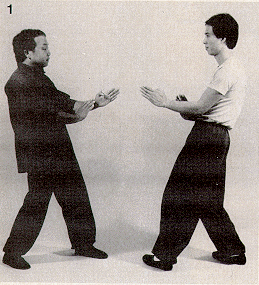

(Note: This above set of 8 photos will take a minute or so to download. It will play in sequence when all downloaded. In meantime, read the article.)
Wing Chun, which means concentration of energy for martial purposes, is a 300 year old style of kung fu (gong fu); kung fu means a skill developed over a long period of time and could refer to any skill, including chinese martial arts. Wing Chun was invented by the Han people to defeat the Qing oppressors; the Han rebels needed to train their people fast so they could beat the well trained Qing soldiers. So they devised a scientific artform designed to kill the opponent with little effort. That style is Wing Chun Kuen or Yong chun quan in mandarin, meaning everlasting spring fist. There are 3 forms in Wing Chun: siu lim tau, chum kiu, and biu jee; then there iss the wooden dummy form, muk yan jong, and the 2 weapons, bart jam dao and luk dim boon kwun. Chi sau or sticky hands is an exercise of putting wrist on wrist and sparring with the opponent; by doing that, you stay close to your opponent and stick to him so that he can't disengage from you. The Wing Chun fighter develops sensibility in the wrists and arms. So the key points of the Wing Chun style is to stay close, block the opponent's blows, control his arms, and deliver multiple blows of your own.
The Confidence Builder
There is a well known Wing Chun kuen kuit saying, "lui sao hui soong, lut sao jik chung", which means, "as my opponent comes I receive him, as he goes I escort him." Upon loss of contact, I charge forward. So I never retreat but go forward and if I lose contact with his hands, I go forward. I give him no opportunity to retreat or the space to do anything. At the same time, I block with one hand, strike with the other and deliver a kick to his knee, all in one motion that starts and finishes at the same time; he cannot block that. To become an effective Wing Chun fighter takes about six months, about three times per week of concentrated effort to build stamina and conditioning, and learn the basics of movement, staying close, blocking punches, and delivering arm and leg blows of your own.
The Benefits
But the benefits of all that hard work are well worth it: good conditioning of body and mind, self-control, confidence in dealing with people in general and with potentially dangerous situations in particular, etc. Wing Chun is also very good training for females because the legend says it was invented by the nun Ng Mui, although today this is less believed; it was probably a trick to drown the suspicion of the goverment who wanted kung fu to be illegal. But because it is a system based on scientific principles of speed and technique, you do not need brute strength to beat the opponent because the most effective way is to hit faster, quicker, and to be deadly. Wing chun is not a brawl or a show of strenth. Women who practice this style choose it because it fits the frame of a woman. It was designed to be used by the weaker rebels against the stronger goverment soldiers.
The photos shown at the top are of sifu Augustine Fong (in the dark outfit) and demonstrate an attack sequence from techniques of the third form; the thrusting fingers form, biu jee. In real combat, you would do a biu jee to the throat or eyes.
Written by: Marc Gendron (from Canada), who is a 20 year old
disciple of this technique. Marc would be pleased to hear from
anyone wishing more information, especially young ladies. He can be
reached by email at <wingchunprodicalson@yahoo.com>
Return to [ Main Page
]